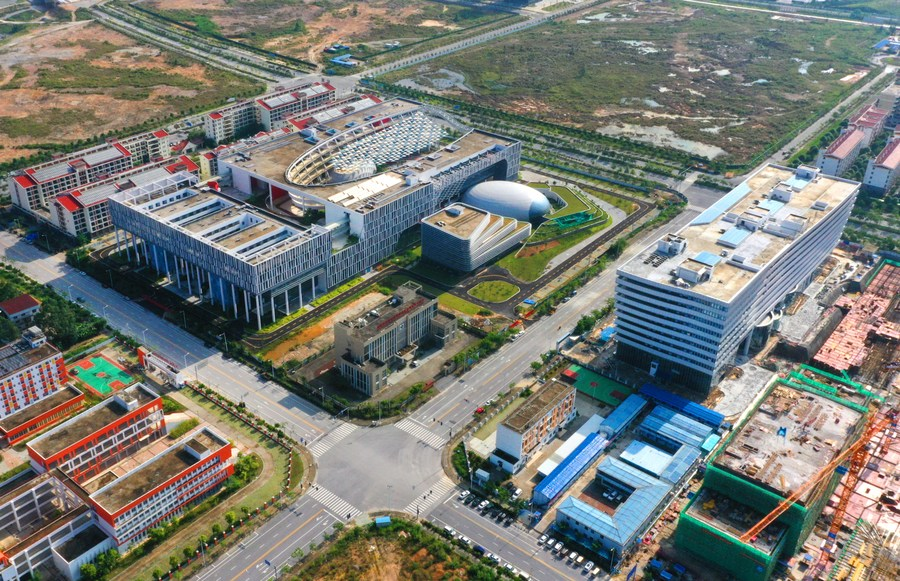
Aerial photo taken on Oct. 6, 2020 shows a view of the China-Malaysia Qinzhou Industrial Park in Qinzhou, south China's Guangxi Zhuang Autonomous Region. (Xinhua/Zhou Hua)
BEIJING, May 10 (Xinhua) -- As the Regional Comprehensive Economic Partnership (RCEP) Agreement came into force for Malaysia on March 18, China-Malaysia trade has seen new dividend and opportunities.
-- Fruitful results in"Two Countries, Twin Parks" cooperation
The Malaysia-China (Guangxi) Investment Forum and celebrations of the 10th anniversary of the "Two Countries, Twin Parks" initiative between China and Malaysia was held in Nanning, capital of south China's Guangxi Zhuang Autonomous Region in late April.
The "Two Countries, Twin Parks" initiative, a landmark project under the Belt and Road Initiative (BRI), has yielded fruitful results during the past decade. Under the RCEP, the cooperation is expected to be further enhanced and upgraded.
At the event, Chinese and Malaysian companies have signed investment or strategic cooperation agreements on 11 projects involving cross-border logistics, industries and trade.
Among them, projects concerning the two industrial parks, the China-Malaysia Qinzhou Industrial Park and the Malaysia-China Kuantan Industrial Park will add further logistics support to the construction of cross-border industrial chain.
Other projects in industries of non-ferrous metal, durian and bird's nest soup, will benefit from the RCEP agreement and facilitate the commodity trade between the two countries.
China is willing to jointly implement the RCEP with Malaysia, lend support to the regional industrial chain through the New International Land-Sea Trade Corridor, deepen trade cooperation between the two sides and promote the the co-construction of the Belt and Road (B&R), according to China's Ministry of Commerce (MOC).
China is expected to built the "Two Countries, Twin Parks" cooperation into a role model project in China-ASEAN trade cooperation, with an aim to contribute to regional economic recovery, the MOC added.
The New International Land-Sea Trade Corridor plays an important part in China-Malaysia economic and trade cooperation, said Zou Lei, a researcher with Shanghai Party Institute of CPC.
The New International Land-Sea Trade Corridor is a trade and logistics passage connecting Southeast Asian countries and provincial-level regions of western China, representing a flagship project in the co-construction of the B&R by China and ASEAN countries. It reduces shipping distance, time and logistics costs by applying modern logistics system, according to Zou.
-- Great potential in bilateral investment
China remained the largest trade partner of Malaysia in the first quarter of this year, according to Malaysian official data. The Year 2021 marked the 13th consecutive year of China holding the position.
Malaysia hopes more Chinese enterprises, especially high-tech firms, to invest in the country, said Malaysian former premier Mahathir Mohamad when talking to Chinese Ambassador to Malaysia Ouyang Yujing on May 5.
Malaysia boasts unique market and policy edges to attract Chinese enterprises, such as large population, market size and economic size, sound industrial foundation, which play a key role in regional economic development, and thus becomes a great choice for Chinese enterprises to enter the ASEAN market, according to Zou.
Besides, Malaysia-China Kuantan Industrial Park offers a slew of favorable policies, such as 15-year tax exemption, which could help enterprises sustain multinational business, gain foothold in local market and expand regional market.
Zou pointed out that the two sides could explore cooperation opportunities in emerging fields, including e-commerce, digital trade, big data, cloud computing, new energy vehicle, bio-medicine and new material.
(Edited by Li Shimeng with Xinhua Silk Road, lishimeng@xinhua.org)




 A single purchase
A single purchase









